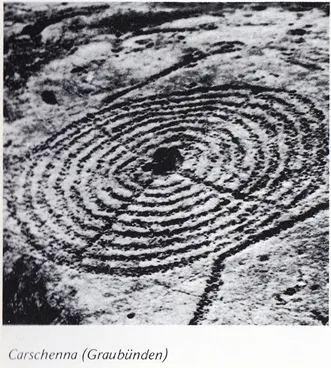
Anybody who has a child or is amazed by the innocence of babes cannot wait to see what comes out of them by way of fantasy and intelligence. One integral aspect of their development is their spontaneous impulse to pick up a crayon (or any implement and/or colouring agent that leaves an impression) and convert their energy into a linear and two dimensional representation. This drawing is not art, but some of it could be hung up persuasively in any modern art gallery. In its very first stages it isn't representational of any concrete thing (table, chair, or mummy, daddy). What does it mean to say then?

Charicteristically, these scribbles and scratches mark out a steady progress (or possible delays and anomalies) throughout the formative years. For this reason, it's a favorite diagnostic tool in psychology, but in anthroposopical pediatrics not everything expressed by the young child is an indiction of their state of mind directly. Especially in the under fives we may discern the sub-conscious awareness of non-mental processes. These turn out to correspond fascinatingly to aboriginal or so called primative art forms, including pre-historic "art", and as such it may inform us of another universal and timeless language of the total human being, belonging to the life-processes and inner workings of the spirit-soul. In short, toddler art is in a cosmic language we have forgotten to speak and understand by the time we turn parents. Let me give you a brief refresher course.



FiveCoso Patterned-body-anthropomorphs, Renegade Canyon on the China Lake, CA, Navy Base. More Owen's valley petroglyphys on Windyscotty's Blog
 |
| 
We are born all curled up and it takes about three years for us to unfurl the frond and find ourselves designed as vertical beings. We are walking trees! This is often reflected in children's drawings where a tangled spiral of a head stands like a lollipop on a thick pillar (quite floating, still, in pre-natal bliss).

This is preceded by the pure dynamic of the centripetal spiral which is an expression of incarnation. The child still experiences this inflow in all she is and does while her etheric/life-formative force is vibrantly at work finishing off the uncurling of the embryo till the child's seventh year. The circular motions reflect the circulatory, upbuiliding processesses which only come to rest in a circle proper around the age of 2, when the child gets a sense of self. Between the ages of 2-3 she discovers herself to be an I: a self contained unit, or circle with a centre. This core becomes a support and an aspiration, much like a ladder, depicting as such the vertebrae, but also indirectly the entire neural network (running through this column) of thinking that is gradually being laid. This may also give the sense of being trapped, in a cage, and around the same time children tend to get nightmares, for the sub-conscious realisation that the soul is meant to be fettered to earth in this evermore hardenening sheath.
Albeit that the drawing is still part of the metabolic experience of the child and not a conscious attempt to communicate any feelings, let alone ideas, the crystallisation process of thinking has started and it makes the shapes more sure and the searching pendulum movements of frantic scratches turn into distinct crosses, marking the spot of "here I stand: an upright being in a space with a horizon, an above and a below. " Man has found himself fallen to earth.

These ur-forms representing the basic dynamics of our willing (drawing/action) as fed by metabolic processes and nerve-sense forces, can be found in all pure expressions of self in man around the globe, throughout all the ages. They don't just mean to reveal the state of our subconscious (bodily functions) either. But they communicate more subtle and occult (hidden/shaded) mysteries for which we must invent narratives that makes sense to us, in a modern language of conscious, clear thinking. Then the pictures become ever more complex, detailed, explanitory and exploratory. Then we get modern art (post Medieval, perspectival, subjective), which is to travel seas unsailed by reasoning eyes, but very much familiar to the first people of our planet.